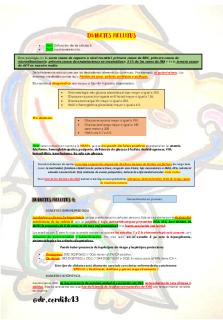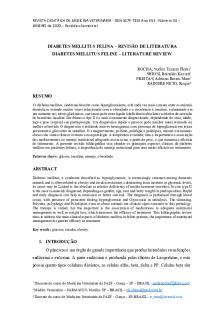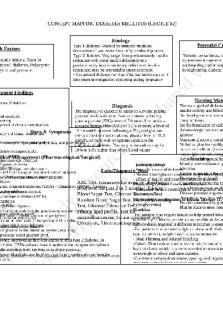Lewis Chapter 049 Nursing Management- Diabetes Mellitus PDF

| Title | Lewis Chapter 049 Nursing Management- Diabetes Mellitus |
|---|---|
| Author | Paul Kim |
| Course | Pathophysiology/Pharm Ii |
| Institution | Baylor University |
| Pages | 6 |
| File Size | 151.8 KB |
| File Type | |
| Total Downloads | 107 |
| Total Views | 144 |
Summary
Simplified diabetes notes...
Description
Lewis: Medical-Surgical Nursing, 9th Edition Chapter 49 Nursing Management: Diabetes Mellitus KEY POINTS
DIABETES MELLITUS Etiology and Pathophysiology Diabetes mellitus is a chronic multisystem disorder of glucose metabolism related to absent or insufficient insulin, impaired utilization of insulin, or both. Current theories link the causes of diabetes to genetic, autoimmune, and environmental factors. Type 1 Diabetes Mellitus Type 1 diabetes mellitus typically occurs in people who are under 40 years of age, with 40% developing it before 20 years of age. It may occur at any age. Type 1 diabetes is the result of a long-standing process in which the body’s own T cells attack and destroy pancreatic cells, which are the source of the body’s insulin. Because the initial manifestation of type 1 diabetes is rapid, the symptoms are usually acute. The classic symptoms—polyuria, polydipsia, and polyphagia—are caused by hyperglycemia. The individual with type 1 diabetes requires insulin therapy to sustain life. Without insulin, the patient will develop diabetic ketoacidosis (DKA), a life-threatening condition resulting in metabolic acidosis. Type 2 Diabetes Mellitus Type 2 diabetes mellitus accounts for over 90% of patients with diabetes. In type 2 diabetes, the pancreas usually continues to produce some insulin. However, the insulin that is produced is either insufficient for the needs of the body and/or is poorly used by the tissues. The most important risk factor for developing type 2 diabetes is believed to be obesity, specifically abdominal and visceral adiposity. The manifestations of type 2 diabetes are more nonspecific and include fatigue, recurrent infections, recurrent vaginal yeast infections, prolonged wound healing, and visual changes. Prediabetes Prediabetes is a condition in which blood glucose levels are higher than normal but not high enough for a diagnosis of diabetes. Those with prediabetes will usually develop type 2 diabetes within 10 years if no preventive measures are taken.
Copyright © 2014 by Mosby, an imprint of Elsevier Inc.
Key Points
49-2
Long-term damage to the body, especially the heart and blood vessels, may already be occurring in patients with prediabetes
Gestational Diabetes Gestational diabetes develops during pregnancy and is usually screened for and detected at 24 to 28 weeks of gestation by an oral glucose tolerance test. Although most women with gestational diabetes will have normal glucose levels within 6 weeks postpartum, their risk for developing type 2 diabetes in 5 to 10 years is increased. Diagnostic Studies A diagnosis of diabetes is based on one of four methods: fasting plasma glucose, random plasma glucose measurement, 2-hour oral glucose tolerance test, and/or an A1C test. Collaborative Care The goals of diabetes management are to reduce symptoms, promote well-being, prevent acute complications of hyperglycemia, and prevent or delay the onset and progression of long-term complications. These goals are most likely to be met when the patient is able to maintain blood glucose levels as near to normal as possible. Drug Therapy: Insulin Exogenous (injected) insulin is needed when a patient has inadequate insulin to meet specific metabolic needs. Insulin is divided into two main categories: short-acting (bolus) and long-acting (basal) insulin. o Bolus insulin is used at mealtimes to combat postprandial hyperglycemia. o Basal insulin is used to maintain a background level of insulin throughout the day. A variety of insulin regimens are recommended for patients depending on the needs of the patient and his or her preference. Insulin is most commonly given by subcutaneous injection. IV administration of regular insulin can be given when immediate onset of action is desired. The speed with which peak serum concentrations are reached varies with the anatomic site for injection. The fastest subcutaneous absorption is from the abdomen. An insulin pump can be used to administer continuous regular insulin. It is programmed to deliver a continuous infusion 24 hours a day with boluses at mealtime. Hypoglycemia, allergic reactions, lipodystrophy, and the Somogyi effect are problems associated with insulin therapy. o Lipodystrophy may occur if the same injection sites are used frequently. The incidence has decreased with the use of human insulin. o Increased morning glucose levels may be due to the Somogyi effect. This is a rebound caused by hypoglycemia during the night that stimulates a counterregulatory response. o The Dawn phenomenon is characterized by hyperglycemia that is present on awakening in the morning, resulting from the release of counterregulatory hormones in the predawn hours.
Copyright © 2014 by Mosby, an imprint of Elsevier Inc.
Key Points
49-3
Drug Therapy: Oral and Noninsulin Injectable Agents These agents primarily work on the three defects of type 2 diabetes: (1) insulin resistance, (2) decreased insulin production, and (3) increased hepatic glucose production. Oral Agents Metformin (Glucophage) is a biguanide glucose-lowering agent. The primary action of metformin is to reduce glucose production by the liver. The ADA algorithm for the management of type 2 diabetes recommends the use of metformin combined with lifestyle interventions as the first-line therapy option. Sulfonylureas increase insulin production from the pancreas. Since they can cause hypoglycemia, it is important to teach patients how to recognize and manage low blood glucose. Sulfonylureas are often added if metformin and lifestyle interventions are not effective. Meglitinides also increase insulin production from the pancreas. Because they are more rapidly absorbed and eliminated, they offer a reduced potential for hypoglycemia. They must be taken before meals, usually resulting in dosing three times a day. α-Glucosidase inhibitors, also known as “starch blockers,” work by slowing down the absorption of carbohydrate in the small intestine. Thiazolidinediones are most effective for people who have insulin resistance. Due to their severe adverse effects, the two drugs in this class are rarely used. Dipeptidyl peptidase IV (DPP-4) inhibitors slow the degradation of the incretin hormone GLP-1, resulting in inhibited secretion of glucagon, increased insulin secretion, slowed gastric emptying, and decreased appetite. Noninsulin Injectable Agents Glucagon-like peptide (GLP)-1 receptor agonists target the incretin hormones. These medications improve glycemic control and have the additional effect of reducing body weight. Pramlintide (Symlin) is a synthetic analog of human amylin, a hormone secreted by the β cells of the pancreas. It is only taken concurrently with insulin and its use improves glycemic control. Nutritional Therapy The overall goal of nutritional therapy is to assist people with diabetes in making healthy nutritional choices, eating a varied diet, and maintaining exercise habits that will lead to improved metabolic control. For those with type 1 diabetes, day-to-day consistency in timing and amount of food eaten is important for those individuals using conventional, fixed insulin regimens. Patients using rapid-acting insulin can make adjustments in dosage before meals based on the premeal blood glucose level and the carbohydrate content of the meal. The emphasis of nutritional therapy in type 2 diabetes is placed on achieving glucose, lipid, and blood pressure goals as well as achieving weight loss if the patient is overweight or obese. In a general diabetic meal plan, carbohydrates and monounsaturated fat should provide 45% to 65% of the total energy intake each day. Fats should compose no more than 25% Copyright © 2014 by Mosby, an imprint of Elsevier Inc.
Key Points
49-4
to 30% of the meal plan’s total calories, with less than 7% of calories from saturated fats. Protein should contribute 15% to 20% of the total energy consumed. Encourage patients to frankly discuss the use of alcohol with their health care providers because its use can make blood glucose more difficult to control. Regular, consistent exercise is an essential part of diabetes and prediabetes management. Exercise increases insulin sensitivity and can have a direct effect on lowering the blood glucose levels.
Monitoring Blood Glucose Self-monitoring of blood glucose (SMBG) is a cornerstone of diabetes management. By providing a current blood glucose reading, SMBG enables the patient to make selfmanagement decisions regarding diet, exercise, and medication. The frequency of monitoring depends on several factors, including the patient’s glycemic goals, the type of diabetes that the patient has, the patient’s ability to perform the test independently, and the patient’s willingness to perform SMBG. Bariatric Surgery Bariatric surgery may be considered for patients with type 2 diabetes who have a BMI greater than 35 kg/m2, especially if the diabetes or associated co-morbidities are difficult to control with lifestyle and drug therapy. Pancreas Transplantation Pancreas transplantation can be used as a treatment option for patients with type 1 diabetes mellitus. Transplants are done for patients with end-stage kidney disease and who had or are having a kidney transplant. NURSING MANAGEMENT: DIABETES MELLITUS Nursing responsibilities for the patient receiving insulin include proper administration, assessment of the patient’s response to insulin therapy, and teaching of the patient regarding administration of, adjustment to, and side effects of insulin, particularly recognition and management of hypoglycemia. Proper administration and assessment of the patient’s use of and response to oral and noninsulin injectable agents, as well as teaching of the patient and the family about these drugs are all part of the nurse’s function. The goals of diabetes self-management education are to enable the patient to become the most active participant in his or her care, while matching the level of self-management to the ability of the individual patient. ACUTE COMPLICATIONS OF DIABETES MELLITUS Diabetic ketoacidosis (DKA) is a life-threatening condition caused by a profound deficiency of insulin. It is characterized by hyperglycemia, ketosis, acidosis, and dehydration. It is most likely to occur in people with type 1 diabetes as compared to type 2. Hyperosmolar hyperglycemic syndrome (HHS) is a life-threatening syndrome that can occur in the patient with diabetes who is able to produce enough insulin to prevent DKA
Copyright © 2014 by Mosby, an imprint of Elsevier Inc.
Key Points
49-5
but not enough to prevent severe hyperglycemia, osmotic diuresis, and extracellular fluid depletion. Hypoglycemia, or low blood glucose, occurs when there is too much insulin in proportion to available glucose in the blood. o Hypoglycemia is often related to a mismatch in the timing of food intake and the peak action of insulin or oral hypoglycemic agents that increase endogenous insulin secretion. o A critical role of the nurse is the prompt recognition of hypoglycemia and the initiation of appropriate treatment dependent on the patient’s status.
CHRONIC COMPLICATIONS OF DIABETES MELLITUS Chronic complications of diabetes are primarily those of end-organ disease from damage to blood vessels from chronic hyperglycemia. These are divided into two categories: macrovascular complications and microvascular complications. o Macrovascular complications are diseases of the large and medium-sized blood vessels that occur with greater frequency and with an earlier onset in people with diabetes. o Microvascular complications result from thickening of the vessel membranes in the capillaries and arterioles, in response to conditions of chronic hyperglycemia. Diabetic retinopathy refers to the process of microvascular damage in the retina because of chronic hyperglycemia. There are two types: proliferative and nonproliferative. Because the earliest and most treatable stages produce no vision changes, persons with diabetes should have an annual dilated eye examination. Diabetic nephropathy is a microvascular complication associated with damage to the small blood vessels that supply the glomeruli of the kidneys. Patients should be screened annually for albuminuria. A measurement of albumin-creatinine ratio from a urine specimen may also be done to assess renal function. Diabetic neuropathy is nerve damage that occurs because of the metabolic derangements associated with diabetes mellitus. The two major categories of diabetic neuropathy are sensory neuropathy, which affects the peripheral nervous system, and autonomic neuropathy. o The most common form of sensory neuropathy is distal symmetric neuropathy, which affects the hands and/or feet bilaterally. o Autonomic neuropathy can affect nearly all body systems and lead to hypoglycemic unawareness, delayed gastric emptying (gastroparesis), constipation, diarrhea, urinary retention, and sexual dysfunction. Complications of Foot and Lower Extremities Foot complications are one of the most common causes of hospitalization in the person with diabetes. Sensory neuropathy is a major risk factor for lower extremity amputation. Proper care of the diabetic foot ulcer is critical to prevent infections. Because of the loss of protective sensations, proper care of the foot in a diabetic patient is critical. Integumentary Complications
Copyright © 2014 by Mosby, an imprint of Elsevier Inc.
Key Points
49-6
Up to two thirds of patients with type 1 and type 2 diabetes develop diabetes related skin problems. Common skin complications include acanthosis nigricans, diabetic dermatopathy, necrobiosis lipoidica diabeticorum, and diabetic thick skin. Because skin is prone to injury, special care must be taken to protect it from injury and ulceration.
Infection A patient with diabetes is more susceptible to infections due to a defect in the mobilization of inflammatory cells and impaired phagocytosis by neutrophils and monocytes. Antibiotic therapy for infections, which must be prompt and vigorous, has prevented infection from being a major cause of death in diabetic patients. Psychosocial Considerations Patients with diabetes have increased rates of mental health disorders, particularly depression. Assess patients for the signs and symptoms of depression at each visit. Individuals with type 1 diabetes, particularly young women, have an increased risk of developing an eating disorder in comparison to people without diabetes. Open and collaborative communication is critical for identifying these behaviors early.
Copyright © 2014 by Mosby, an imprint of Elsevier Inc....
Similar Free PDFs

Diabetes mellitus
- 15 Pages

Diabetes Mellitus
- 3 Pages

Diagnosis Diabetes Mellitus
- 4 Pages

Pathway of Diabetes Mellitus
- 4 Pages

makalah diabetes mellitus
- 10 Pages

DIABETES MELLITUS RESÚMEN CLAVE
- 3 Pages

PAE diabetes mellitus
- 16 Pages

Diabetes Mellitus em gatos
- 8 Pages

Ensayo diabetes mellitus
- 3 Pages
Popular Institutions
- Tinajero National High School - Annex
- Politeknik Caltex Riau
- Yokohama City University
- SGT University
- University of Al-Qadisiyah
- Divine Word College of Vigan
- Techniek College Rotterdam
- Universidade de Santiago
- Universiti Teknologi MARA Cawangan Johor Kampus Pasir Gudang
- Poltekkes Kemenkes Yogyakarta
- Baguio City National High School
- Colegio san marcos
- preparatoria uno
- Centro de Bachillerato Tecnológico Industrial y de Servicios No. 107
- Dalian Maritime University
- Quang Trung Secondary School
- Colegio Tecnológico en Informática
- Corporación Regional de Educación Superior
- Grupo CEDVA
- Dar Al Uloom University
- Centro de Estudios Preuniversitarios de la Universidad Nacional de Ingeniería
- 上智大学
- Aakash International School, Nuna Majara
- San Felipe Neri Catholic School
- Kang Chiao International School - New Taipei City
- Misamis Occidental National High School
- Institución Educativa Escuela Normal Juan Ladrilleros
- Kolehiyo ng Pantukan
- Batanes State College
- Instituto Continental
- Sekolah Menengah Kejuruan Kesehatan Kaltara (Tarakan)
- Colegio de La Inmaculada Concepcion - Cebu






